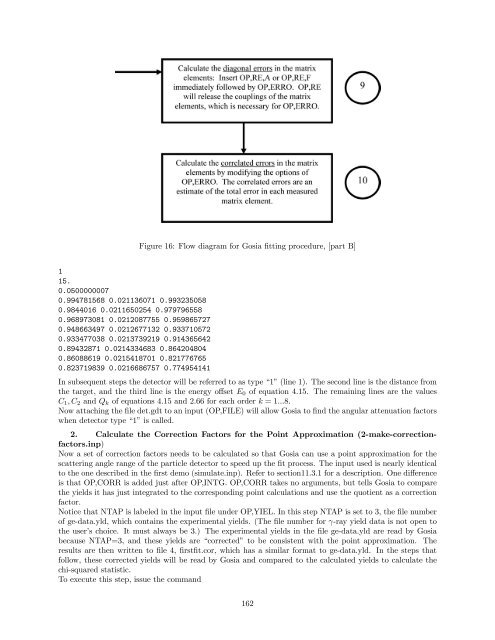coulomb excitation data analysis codes; gosia 2007 - Physics and ...
coulomb excitation data analysis codes; gosia 2007 - Physics and ...
coulomb excitation data analysis codes; gosia 2007 - Physics and ...
You also want an ePaper? Increase the reach of your titles
YUMPU automatically turns print PDFs into web optimized ePapers that Google loves.
Figure 16: Flow diagram for Gosia fitting procedure, [part B]115.0.05000000070.994781568 0.021136071 0.9932350580.9844016 0.0211650254 0.9797965580.968973081 0.0212087755 0.9598657270.948663497 0.0212677132 0.9337105720.933477038 0.0213739219 0.9143656420.89432871 0.0214334683 0.8642048040.86088619 0.0215418701 0.8217767650.823719839 0.0216686757 0.774954141In subsequent steps the detector will be referred to as type“1”(line1). Thesecondlineisthedistancefromthe target, <strong>and</strong> the third line is the energy offset E 0 of equation 4.15. The remaining lines are the valuesC 1 ,C 2 <strong>and</strong> Q k of equations 4.15 <strong>and</strong> 2.66 for each order k =1...8.Now attaching the file det.gdt to an input (OP,FILE) will allow Gosia to find the angular attenuation factorswhen detector type “1” is called.2. Calculate the Correction Factors for the Point Approximation (2-make-correctionfactors.inp)Now a set of correction factors needs to be calculated so that Gosia can use a point approximation for thescattering angle range of the particle detector to speed up the fit process. The input used is nearly identicalto the one described in the first demo (simulate.inp). Refer to section11.3.1 for a description. One differenceis that OP,CORR is added just after OP,INTG. OP,CORR takes no arguments, but tells Gosia to comparethe yields it has just integrated to the corresponding point calculations <strong>and</strong> use the quotient as a correctionfactor.Notice that NTAP is labeled in the input file under OP,YIEL. In this step NTAP is set to 3, the file numberof ge-<strong>data</strong>.yld, which contains the experimental yields. (The file number for γ-ray yield <strong>data</strong> is not open tothe user’s choice. It must always be 3.) The experimental yields in the file ge-<strong>data</strong>.yld are read by Gosiabecause NTAP=3, <strong>and</strong> these yields are “corrected” to be consistent with the point approximation. Theresults are then written to file 4, firstfit.cor, which has a similar format to ge-<strong>data</strong>.yld. In the steps thatfollow, these corrected yields will be read by Gosia <strong>and</strong> compared to the calculated yields to calculate thechi-squared statistic.To execute this step, issue the comm<strong>and</strong>162
















